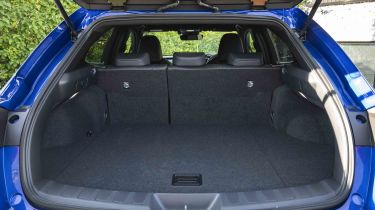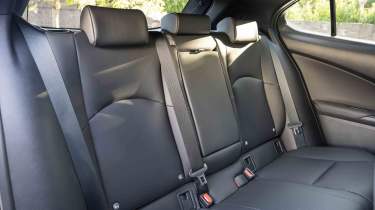Lexus UX - Boot space, comfort & practicality
The Lexus UX's boot is too small, and the space inside the cabin is merely adequate

The Lexus UX doesn’t present an entirely convincing case as a serious family car, and it seems as though it was predominantly designed with front seat passengers in mind. It feels more like a raised hatchback because you sit down into it, instead of climbing up like you might in a high-riding SUV. A lower driving position may appeal to some, while others might prefer a higher perch where you can look down on other motorists.
|
Dimensions | |
|
Length |
4,495mm |
|
Width |
1,840mm (2,078mm inc door mirrors) |
|
Height |
1,540mm (1,545mm 300e) |
|
Number of seats |
5 |
|
Boot space |
320 litres (300h) 367 litres (300e) |
Dimensions and size
At 4,495mm in length, 2,078mm wide with mirrors (but 1,840mm without them) and up to 1,540mm tall, the UX is slightly longer and taller than the BMW X2 but a touch narrower.
The UX is a little longer than a Volvo XC40, but it isn’t quite as wide or tall. This means that the XC40 is bigger inside for passengers and has a larger boot.
Seats, leg room, head room & passenger space
The driver and front seat passenger get the best deal in the UX, with ample headroom and a pleasant feeling of being cocooned behind the wraparound dashboard.
In the back, headroom and legroom would be best described as adequate, with the low-set seats managing to offset the effects of the sloping roofline. Passengers should avoid the middle seat, mind, as it sits higher than the outer rear seats and space for feet and knees is compromised by a centre console that encroaches into the rear. Two ISOFIX points are provided on the outer rear seating positions.
Used - available now
The main issue for those in the back of the UX is that it never feels as spacious and airy as a more conventionally styled SUV, with the narrow rear windows creating a claustrophobic feeling.
Boot space
Both front- and four-wheel drive versions of the 300h have the smallest boot size at 320 litres, which is significantly less than our favourite small SUV, the Hyundai Kona, which has a whopping 466 litres of space in comparison.
Surprisingly, the fully electric UX 300e has the largest boot with all seats in place – it is claimed to be able to swallow 367 litres of cargo. Lexus does not quote a boot size for either version with their rear seats folded, despite a 60:40 folding rear bench being included.
If you’re after a similarly premium electric small SUV, the BMW iX1 has a larger boot of 490 litres. The iX1 also has a more flexible 40/20/40 split folding rear seat.
Towing
Hybrid Lexus UX models have a braked and unbraked towing capacity of 750kg – less than some versions of the Vauxhall Corsa. The UX might be fine for transporting garden rubbish to the tip, but this isn’t an SUV for towing a caravan or boat. As for 300e variants, it isn’t rated to tow anything, so you’ll be better off looking towards the Volvo EX30, which has a 1,600kg towing limit.













